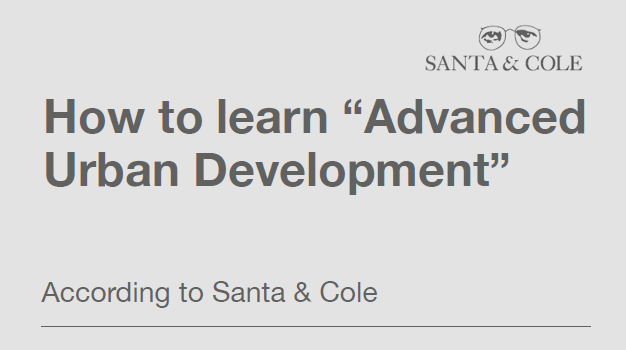
How to learn “Advanced Urban Development” according to Santa & Cole
We at Santa & Cole design and edit urban furniture, elements and lighting fixtures for cities. Since 1985, we have worked on regular cities, modern cities, transgressive cities, renovated cities, smart cities (you name it) and, nowadays, responsive cities. However, as stated herein, the city is a system of systems, an independent environment, a complex living structure or network and our aim is to provide useful solutions for the citizens and users as a whole.
This short introduction is just to set out our role in the face of the highly complex reality of cities. We understand that every background unveils a culture or philosophy. Our aim is to help urban planners, architects and landscapers to transform public space into a humanised environment or public living rooms. To this end, we gather data and knowledge about a liveable space that we wish to share and expand on by teaching and learning at the same time.
Based on our experience, we firmly believe and champion the standpoint that there is more than one means of learning. As demonstrated in this research, there are several practices used in education (whatever the subject); nonetheless, when focussing on responsive cities, or cities in general, we need to merge all of them.
We are always focussed on products, and these products need to address an issue or necessity, be useful or provide a solution. So, for our team – or new possible members (still at university) – problem-based learning is a really good way of achieving the skills to be resourceful when an issue is identified and it was incumbent upon us to offer a solution to it. When we are envisioning new ways, new cities and anticipating new needs, we need to approach suitable new knowledge adopting project-based learning or case-based learning. I am referring to how we normally work, because we believe that students need to be in contact with companies in order to gain an awareness of reality. Every master’s programme or general course should incorporate a substantial part of experimental learning. For us, it is highly important for a student who obtains his or her degree or certification to have already touched on materials, worked in situ and visited, analysed and installed the factual elements on the ground. This means having the chance to be in “contact” with the designs or ideas, and not only drafting them.
In relation to experimental learning, forging programmes that empower employability and association with practice is something we are really keen to engage in. Learning is about sharing knowledge. Everyone in this room today has different backgrounds, different cultures and different educations; therefore, when we form a team and work together we are establishing a new practice for learning: learning by sharing. This is difficult to set up on the context of a university
programme; however, it is highly important nowadays in light of all the Commons and open data, and it is something that enriches companies and practices as we cannot be experts in everything and we can always learn from others.
To sum up, we are really keen on active learning and we have genuinely demonstrated that we learn by doing, making and touching things. Even so, in
our industry we need to tie schools with industry, and projects with administrations and regulations. Sometimes, we form the grassroots organisation
that connects truly differing realms; thus, in our daily jobs there is a large body of cooperative learning while we try to find (or forge) the balance
between creativity and reality.
Text by Àfrica Sabé

